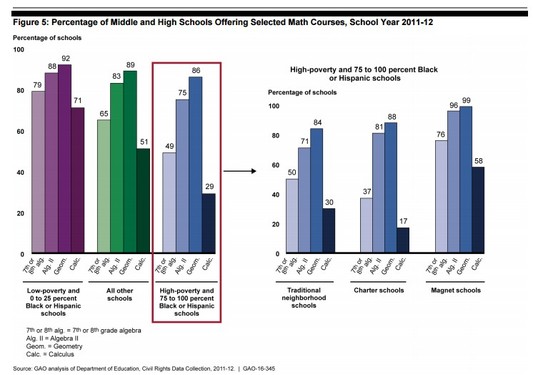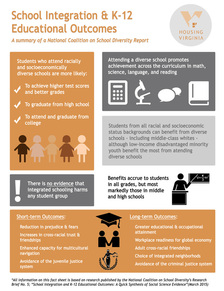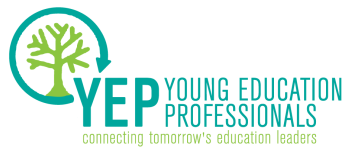
A substantial body of research demonstrates that all students benefit academically, occupationally, and socially from diverse learning environments; yet, for decades, little emphasis has been placed on promoting racially and socioeconomically diverse schools. However, in recent months, a resurgence of federal attention has been paid to school diversity. Here’s a recap of some of the highlights:
GAO Report
On May 17 – the 62-year anniversary of the Supreme Court’s Brown v. Board of Education (1954) ruling that deemed school segregation unconstitutional – the Government Accountability Office (GAO) released a report that found what civil rights researchers have said for decades: that segregation has intensified across racial and socioeconomic lines in our nation’s public schools. According to the recent GAO report, not only are poor, black, and Hispanic students increasingly isolated from their affluent, white peers, but schools with high concentrations of poor students of color (i.e., more than 75 percent of children receive free or reduced-price lunch and more than 75 percent are black or Hispanic) “offered disproportionately fewer math, science, and college preparatory courses and had disproportionately higher rates of students who were held back in 9th grade, suspended, or expelled.” Moreover, the report included case studies of three school districts, located in separate areas of the country, each using different strategies to voluntarily increase racial and socioeconomic diversity, such as utilizing magnet schools, new student attendance zones, and school choice policies.
Dear Colleague Letter
On June 8, the Departments of Education (ED), Housing and Urban Development (HUD), and Transportation (DOT) held a half-day convening and released a joint Dear Colleague Letter calling for cross-agency collaboration to promote racial and socioeconomic diversity in schools and communities. In acknowledging the benefits of school diversity, ED, HUD, and DOT stressed to state and local agencies the need to begin breaking down the silos between education, housing, and transportation policy and planning. Given the relationship between where a child lives and attends school, and the need for reliable transportation between home and school, the Dear Colleague Letter provides examples of how the education, housing, and transportation sectors could better coordinate efforts to encourage racially and socioeconomically diverse schools and communities.
Stronger Together Bill
On July 12, both the Senate Health, Education, Labor, and Pensions (HELP) Committee and the House Education and the Workforce Committee introduced the Stronger Together School Diversity Act of 2016. The bill would amend the Elementary and Secondary Education Act of 1965 (ESEA) and create a $120 million competitive grant program to support new and existing voluntary efforts that promote racial and socioeconomic diversity in schools. Grantees could use funds to “study segregation, evaluate current policies and develop evidence-based plans to address disparities; establish public school choice zones, revise school boundaries or expand bussing services; or create programs to attract students to different schools.” Stronger Together is consistent with President Obama’s 2017 budget and Secretary King’s priority to promote school diversity.

Even the nation’s new federal education law – the reauthorized ESEA or the Every Student Succeeds Act (ESSA) – includes language that prioritizes and could be leveraged to incentivize school diversity. As I’ve stated previously, ESSA expanded federal support for charter schools by authorizing more than $1.1 billion in competitive grants by 2020. The law grants priority to applicants that “plan to operate or manage high-quality charter schools with racially and socioeconomically diverse student bodies.” ESSA also reauthorized the Magnet Schools Assistance Program (MSAP), authorizing increased competitive grant funding for magnet schools to $4.1 million by 2020. MSAP prioritizes replicating magnet school programs that demonstrate “success in increasing student academic achievement and reducing isolation of minority groups… by taking into account socioeconomic diversity.” Magnets have been around since the 1960s to promote voluntary, choice-based school desegregation. In fact, the word ‘magnet’ comes from the idea that a school offering a special theme or curriculum could “attract” families to apply and leave their neighborhood school, thus creating a more racially diverse student body. However, as The National Coalition on School Diversity has noted, funding for magnet schools might be in trouble. On July 14, the House Committee on Appropriations recommended no funding for MSAP, which is currently the only federal grant program explicitly dedicated to reducing segregation. Removing the funding from MSAP would significantly limit federal support for school diversity.
As states begin to implement ESSA, mandates outlined under the new law provide another opportunity to promote school diversity. According to Kara Finnigan et al (2016), states could invest in school diversity as a “school turnaround” strategy. Since ESSA requires states to adopt evidence-based interventions for the lowest performing bottom 5 percent of schools, and school diversity is a research-supported strategy linked to improved student outcomes, (when appropriate) states could use this mandate as an opportunity to invest in these schools by turning them into high-quality racially and socioeconomically diverse magnets. Finnigan et al also point out that states could design their new school accountability systems in a way that incentivizes school diversity. My colleagues have recently talked about ESSA’s requirement to include a nonacademic “Fifth Indicator” in state accountability systems to access school quality or student success. According to Finnigan et al, states could incentivize school diversity by incorporating it as one measure of school quality and reward schools that are making progress on becoming more racially and socioeconomically diverse. See here for a summary of ED’s proposed regulations on accountability and state plans under ESSA.
What’s Next?
The recent federal movement on school diversity is exciting, but what does it all mean? Will the GAO report spur more research and awareness about the current reality of school segregation? Will the Dear Colleague Letter lead to a more coordinated effort on behalf of education, housing, and transportation agencies to promote diverse schools and communities? Will Stronger Together become law and provide funding for new and existing school diversity efforts? Will states take advantage of the opportunities available under ESSA through competitive grants and mandates that could be used to incentivize school diversity? We will have to wait and see.
Jenna Tomasello is a Policy Associate at the American Youth Policy Forum. Her work involves the development of learning events and the dissemination of policy and practice guidance to frame issues, inform policy, and convene conversations that improve education and the lives of vulnerable students and youth. Feel free to connect with Jenna on Twitter or LinkedIn.

 RSS Feed
RSS Feed